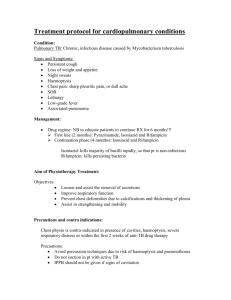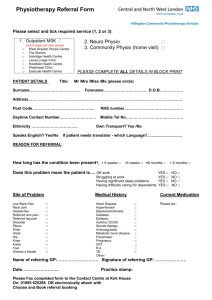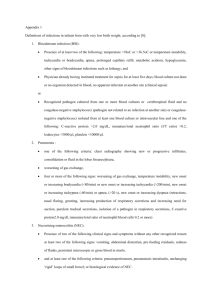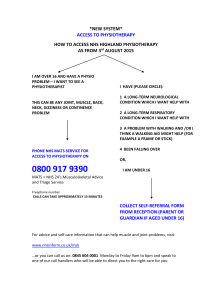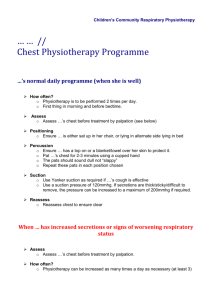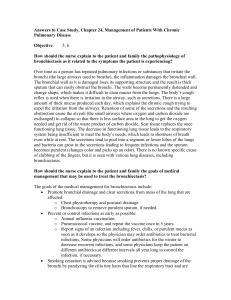Bronchiectasis
advertisement
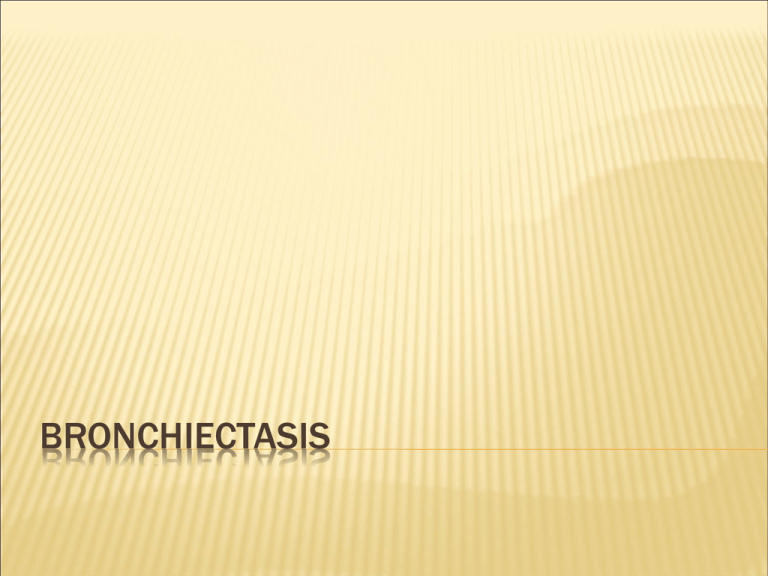
BRONCHIECTASIS DEFINITION Permanent dilatation of one or more bronchi Elastic and muscular tissue of bronchial walls destroyed by acute and chronic infection Impaired drainage of secretions Secretions chronically infected Chronic inflammatory response Progressive destructive lung disease BRONCHIECTASIS COMMON CAUSES Common causes of Bronchiectasis Post-infective Tuberculosis Measles Whooping cough Mucociliary clearance defect CF PCD Young’s syndrome Immune defects Immunoglobulin deficiency Cellular defects ABPA Localized bronchial obstruction Gastric aspiration Foreign body Benign tumour External compression CLINICAL FEATURES Totally asymptomatic to severe disease Productive cough with large amounts of purulent secretions, sometimes haemoptysis Frequently admitted to hospital Exacerbations – chest pain, dyspnoea, fever If accompanied by CF or PCD – sinus disease with nasal blockage, purulent discharge, and facial pain Auscultation – coarse crepitations, wheezing Usually no clubbing DIAGNOSIS AND INVESTIGATIONS Assessment X-ray CT Sputum specimen Bronchoscopy Lung function Serum immunoglobulins ABPA Gene mutation analysis Electron microscopy MEDICAL MANAGEMENT Clearance of infected secretions Physiotherapy Treating infections Antibiotics Oral, intravenous, nebulized OTHER TREAMENT MEASURES Influenza vaccination Treatment of rhinosinusitis Immunoglobulin replacement therapy Surgical resection Inhaled human deoxyribonuclease (rhDNase) Inhaled steroids and bronchodilators PHYSIOTHERAPY Problems: Excess bronchial secretions Dyspnoea ↓ exercise tolerance Chest wall pain (musculoskeletal) EXCESS BRONCHIAL SECRETIONS Patient must understand pathology and reason for treatment ACBT, AD, Flutter Becareful of head-down tip - GOR Self treatment important daily Time of day? Physio techniques reassessed Improved ventilation Hypertonic saline ACUTE EXACERBATION Hospitalised - ↑ secretions or more purulent, dehydrated, dyspnoea. Haemoptysis and pleuritic pain Nebulized bronchodilator and humidification IPPB - ↓ work of breathing Post-resection – changed anatomy of bronchial tree – find optimal position Blood streaking in sputum – continue Rx. Frank haemoptysis – discontinue Continue Rx when secretions mildly bloodstained DYSPNOEA ↓ EXERCISE TOLERANCE Inhalation with bronchodilator Relaxation positions and breathing control Exercise to ↑ fitness and ↓ secretions Group pulmonary rehab programme IMT CHEST WALL PAIN - MUSCULOSKELETAL Anti-inflammatory drugs and analgesics Heat IF TENS Acupuncture Manual therapy EVALUATION OF PHYSIOTHERAPY Effective treatment: ↓ amount and purulence of sputum no fever ↑ spirometry ↑ exercise tolerance ↑ energy levels ↓ dyspnoea ↓ chest wall pain PRIMARY CILIARY DISKINESIA (PCD) PCD PCD Abnormal cilia structure Normal structure abnormal function No cilia PCD (CONTINUED) Infections in nose, ears, sinuses and lungs Fertility affected (fallopian tubes and sperm motility) Dextrocardia or situs inversus Previously immotile cilia syndrome Chronic sputum production and nasal symptoms PCD - SYMPTOMS Pneumonia, rhinitis, asthma Otitis media GOR Infertility and ectopic pregnancy Investigations: nasal mucociliary clearance test genetic testing MEDICAL Antibiotics Assess and monitor hearing Inhaled B2-agonist GOR – proton pump inhibitor PHYSIOTHERAPY Daily physio Teach parents early signs of infection Lethargy, “off colour”, fever Secretions mostly in dependant areas Airway clearance techniques Huffing games Exercises Nasopharyngeal suctioning EVALUATION OF PHYSIO Effective Rx: minimal coughing on exertion ↓ dyspnoea, coughing, wheezing ↓ fever ↓ secretions (back to usual amount) CYSTIC FIBROSIS CF CF Chronic pulmonary disease Pancreatic insufficiency ↑ electrolites in sweat CF (CONTINUED) Autosomal recessive Caucasian populations Life expectancy was 2 years, now 31 years Faulty gene - CFTR CF (CONTINUED) Abnormality in protein (CFTR) Changes in ion transport Changes in mucus and serous secretions produced by exocrine glands, respiratory system and digestive tract CF (CONTINUED) Ion transport → absorption of sodium ions from mucosal surface → movement of water into epithelial cells. Balance between movement of sodium and chloride → volume and composition of of airway surface liquid and mucociliary clearance CF (CONTINUED) Normal lung at birth Inflammation and infection Mucus secretion and obstruction Destroys lung tissue (bronchiectasis) Peptides and neutrophil elastase Neutrophil bronchiolitis ↓ ciliary function and mucus clearance Chronic hypoxia and pulmonary hypertension Respiratory failure DIAGNOSIS AN PRESENTATION Newborn screening DNA testing Symptoms of respiratory and GI symptoms Failure to pass meconium (meconium ileus) Healthy apeptite, but failure to thrive (malabsorption and hyposecretion of enzymes by pancreas) Streatorrhoea (fatty and offensive stools) ↑ concentration of sweat chloride SIGNS AND SYMPTOMS - RESPIRATORY Productive cough Chest pain – musculoskeletal or pleuritic Dyspnoea (infection or as disease progresses) Pneumothorax Haemoptysis Clubbing Coarse crepitations Pleural rub Nasal polyps Chronic sinusitis Bronchial wall thickening Hyperinflation Nodular shadows Pulmonary function – initially obstructive, later restrictive Ventilation/perfusion imbalance Hypoxaemia, CO2 retention Pulmonary hypertension ABPA SIGNS AND SYMPTOMS – GI AND OTHER Obstruction of small bowel with Abdominal distension and discomfort Vomiting and ↓ or no bowel signs CFRD Biliary cirrhosis Portal hypertension Bleeding Liver transplant Puberty delayed Normal or near normal fertility in women Men infertile Rheumatic symptoms Joint pain, swelling, ↓ ROM of knees, ankles and wrists Low bone mineral density Fractures, rib fractures MEDICAL MANAGEMENT Pulmonary function and nutrition important Interdisciplinary team Morbidity and mortality related to chronic infection → oral, nebulized and intravenous antibiotics Important to wash hands between patients, contamination of nebulizers Inhaled bronchodilators and steroids Hypertonic saline MEDICAL MANAGEMENT (CONTINUED) High energy intake Fat-soluble vitamins and vitamin K, pancreatic enzymes Cortcosteroid nasal spray Haemoptysis – will stop spontaneously, embolization Pneumothorax – resolve without Rx or with ICD Heart-lung and double lung transplant Palliative care HOME TREATMENT Home treatment less disrupting than hospitalisation IV antibiotics at home Home visits Physio doing home Rx Patient must take responsibility for own Rx Future: Gene therapy Stem cell therapy PHYSIOTHERAPY MANAGEMENT Accurate assessment and Rx for every individual patient ↓ secretions, ↑ exercises Education with regards to inhalation therapy / oxygen therapy Musculoskletal pain, low bone density Urinary incontinence Work with patient and family / carers – realistic Rx plan PHYSIO – INFANTS AND SMALL CHILDREN Before feeds for 10-15 minutes ↑ frequency and duration during infection PEP facemask AD Physical activity Head-down tip - ↑ GOR Routine daily airway clearance – not required if no symptoms PHYSIO – INFANTS AND SMALL CHILDREN Physical activity very important – something they would enjoy Play active role in Rx Encourage child to expectorate Learn to blow nose AIRWAY CLEARANCE Main aim CF secretions - ↑ viscoelastisity, dehydrated, hyperadhesive Mobilize secretions without ↑ obstruction or fatigue ↑ airflow, ↑ long volumes, alter properties of secretions Huffing Rather ↑ ventilation than ↑ drainage AIRWAY CLEARANCE (CONTINUED) Patient preference Airway clearance once a day with exercise Some patients may require Rx 2-3x a day EXERCISES ↑ exercise tolerance Make a given level of exercise more comfortable and ↑ADL Endurance: swimming, cycling, running Strength training: weights Interval training Intensity 20-30 min, 3-4x per week EXERCISES (CONTINUED) Weight that can be lifted comfortably 10-15x, progress to 20-30x and then ↑ weight 15-30 minutes, every second day Warm-up, stretches and cool down Be careful with strengthening training in children 8-12 repititions without fatigue PRECAUTIONS No absolute contraindications but exercise should not be done if patient has: Abdominal obstruction Acute bronchopulmonary exacerbation with fever Arthralgia and athritis Pneumothorax Persistent haemoptysis Surgery PRECAUTIONS (CONTINUED) Exercise –induced bronchoconstriction Hot climates DM Sport: contact sports bungee jumping parachute jumping scuba altitude (skiing) EXERCISE WITH ADVANCING DISEASE Not excluded Maintenance Oxygen – before and after exercise INHALATION THERAPY Beta-adrenergic drugs B2-agoniste Hypertonic saline with ultrasonic nebulizer Bronchoconstriction – test dose ACUTE BRONCHOPULMONARY INFECTION ↑ cough and sputum, ↓ in spirometry ↓ exercise tolerance Weight loss Lack of energy Dyspnoea Fever Chest pain ↑ duration and frequency of Rx – manual techniques Positioning OXYGEN THERAPY ↑ than normal drive to breathe - ↓ PCO2 Inspiratory time↑ which ↑work of breathing Don’t chronically retain PCO2 Hypoventilate at night - oxygen COMPLICATIONS Advanced CF ABPA : narrowing of airways gas trapping small airways disease mucus plugs (collapse) wheezing Arthropathy: pain, swelling hot joints, effusions COMPLICATIONS (CONTINUED) Diabetes: DIOS: polyuria→dehydration→ sticky secretions insulin requirements change during exercise abdominal pain distension vomiting palpable fecal masses obstruction COMPLICATIONS (CONTINUED) GOR Haemoptysis Liver disease Low bone mineral density Musculoskeletal dysfunction Pneumothorax Pregnancy Surgery Transplantation Incontinence EVALUATION OF PHYSIO Sputum weight Lung function Blood gases VAS, Borg scale, QOL Adherence!! REFERENCES Pryor, J.A. and Prasad, S.A. 2008. Physiotherapy for respiratory and cardiac problems. Adults and Paediatrics. Edinburgh: Churchill Livingstone
